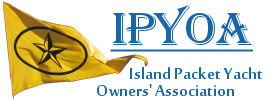- Posts: 15
- Thank you received: 2
- Forum
- Ask for System Help / Share Solutions
- Yacht Systems
- Anchors and Windlasses
- Anchor Windlass with 2 Anchors IP29
Anchor Windlass with 2 Anchors IP29
- rwpajak
-
 Topic Author
Topic Author
- Offline
- New Member
-

What is the best electric windlass for a boat the size of the IP29? Any good/bad experiences?
Please Log in or Create an account to join the conversation.
- hayden
-

- Offline
- Moderator
-

I would simply drop the chain off the primary windlass, freeing it up to pull in the secondary anchor. This is easier on a horizontal windlass as the chain can easily be lifted off.
The windlass I would look at are made by IMTRA.com. You can buy these from defender, but this is the company:
www.imtra.com/product/anchoring_systems/...electric_winches.htm
For an IP29, I would look at the CAYMAN of TIGRES.
I replaced our SL 1000 with a Tigres and love it, it is a fantastic machine!
Hayden
Hayden Cochran
IP35-165 Island Spirit
IslandSpirit35.blogspot.com
Rock Hall, MD
Please Log in or Create an account to join the conversation.
- rwpajak
-
 Topic Author
Topic Author
- Offline
- New Member
-

- Posts: 15
- Thank you received: 2
Nice windlass but expensive! I was looking for something in a vertical windlass along the lines of my current manual lewmar (which doesn't drop the chain/rode blind into the anchor locker) hoping I could lift off the primary rode and drop on the secondary. Much cheaper , too, and priced appropriately for an IP29. I'd never recover the $3-4K for an Imtra
Now, if I had the IP35.......
Please Log in or Create an account to join the conversation.
- hayden
-

- Offline
- Moderator
-

Did you look at windlasses at Defender?
www.defender.com/category.jsp?path=-1|10391|29596&id=321924
Hayden
Hayden Cochran
IP35-165 Island Spirit
IslandSpirit35.blogspot.com
Rock Hall, MD
Please Log in or Create an account to join the conversation.
- ErBrown
-

- Offline
- Junior Member
-

- Posts: 24
- Thank you received: 0
hayden wrote: Bob:
I would simply drop the chain off the primary windlass, freeing it up to pull in the secondary anchor. This is easier on a horizontal windlass as the chain can easily be lifted off.
Hayden
Hayden, we're in the process of ordering a new windlass (Lighthouse 1501) and have been going through the various gypsy/rope drum options. One of the concerns I have is with respect to managing a second anchor. We'd like to save the cost of a second gyspy but not if it compromises usability. Like you, we're planning to go with an oversized Rocna as our primary. For this reason, I believe it will be very rare to need the secondary so am hesitant to spend the $$ on a second gypsy fpr the port side. I'm curious though, for a horizontal windlass, similar configuration to your Tigres, how well are you able to use the starboard side gypsy for the port anchor when needed?
Our goal is to carry as much chain on the primary as possible (likely 250' of 3/8" chain) for the primary. Which due to space/weight would likely mean the secondary would be primarily rope rode with 50-75' of chain. I just want to be sure this single gypsy is feasible in this scenario. Of course the gyspy and rope drum can always be field swapped (port for starboard) of you needed to use the secondary for an extended period of time but this is not something one would want to do regularly and having the secondary ready to go, just in case is also important.
Thanks,
Erin
Please Log in or Create an account to join the conversation.
- hayden
-

- Offline
- Moderator
-

This is because our secondary anchor is all rode and with the Lofrans Tigress we can just use the rope drum. That is why we drop off the chain, or we can loosen the brake and freewheel the gypsy.
Again, we had the Lighthouse 1501 windless paid for an waited months to receive. They only make a few at a time, small shop. When it was not even started yet and I needed it I called them and canceled the order and bought the Tigress. The money saved paid for the 10 foot AB new dinghy. Why do you think you need the Lighthouse 1501 over the well proven Tigress? Just wondering.
Installation of the lighthouse requires you being under the deck and bolting their massive motor up to the underside of the unit. Yes, it is a work of art, but at the cost, it should be gold plated. The tigress will pull your boat right up to the anchor and it never strains. It is a piece of cake to install, 4 dolts. It is even easier to service. Pull the motor, change the oil, install new brushes. To me, it is great.
Hayden
Hayden Cochran
IP35-165 Island Spirit
IslandSpirit35.blogspot.com
Rock Hall, MD
Please Log in or Create an account to join the conversation.
- ErBrown
-

- Offline
- Junior Member
-

- Posts: 24
- Thank you received: 0
Please Log in or Create an account to join the conversation.
- Delicia
-

- Offline
- Premium Member
-

- Posts: 107
- Thank you received: 16
On Delicia, We recently removed the original below deck Simpson Lawrence Windlass and replaced it with a HRC10-8 Maxwell, $1700. It is an excellent windlass. Less than half the price of a Light House. We had a Maxwell RC Series RC10-10 Vertical Windlass on our 350. Maxwell makes good products. It was also an excellent windlass but it was a below deck, vertical windlass. If we had maintained it as directed, i.e. removed and greased every 6 months it would have worked much longer. But I didn't, and motor became "one piece" mated forever with the gear box, as things tend to do in the saltwater. Here is the basic problem, which makes deck mounted windlasses superior - - PERIOD. All, electric windlasses use big DC starter motors, usually 12v, These motors all have a mild rolled steel cases and iron magnets with copper windings plus other copper parts. Even on the vaulted Light House. These are motors, by economic necessity, come from the high production volume auto/trucking industry because they are affordable components. Also DC motors need to have iron and copper parts. So.... when they get wet they rust and corrode. Look at the pictures on the Defender Web site. While the working heads of these pretty windlasses are fancy chrome plated bronze, the below deck parts truck starter motors - usually Italian - and they go fast when they get salt water wet. While below deck seems like a great idea, in reality it is terrible, because the chain drips on them and they live un protected in the warm wet chain locker. The salt water from the chain along with the mud and other stuff drip all over the motor and connections, it never dries out in there. If you don't remove, clean and grease the motors and connections frequently they fail and they corrode and become "one" with their aluminum case gear boxes. If they are mounted on deck in a nice fiberglass box they stay much dryer and easier to service. Removing the failed windlasses on my 350 an IP40 was hard. You can't use a big hammer because you will destroy the deck. On the IP40 I used a 5/8" drill bit to cut around the shaft and the a cold chisel to cut the rest of it when I removed the Simpson Lawrence. On the 350 I used a Saws-All to remove the below deck Maxwell. The Light House attempts to solve this problem with by using a robust looking case to protect the motor which hangs in the slop below deck. The rest of it is nothing special - a worm gear drive like most of the others. You have to cut a fairly large hole in the deck to accommodate the motor and case.
And while I am on this rant - Manual windlasses work well and are really "salty" looking. - BUT, they are slow, require lots of effort, and it you have to anchor several times to get it "right" like many of us do, you are tempted to say "hell with it" that is good enough "I don't feel like pulling the anchor one more time". Also in a 40k squall at 3 AM it is nice to be able to have your female significant other get the anchor up quickly while you motor off through the dark anchorage around the other boats that are dragging down on you. If you have a remote switch at the helm, (not a big expense) you can do the 3 AM drill alone and she can sleep, or if you are single handing you can do it alone because you have no other option. The single hand anchor drill is very hard to do safely do with manual windlass in a crowded anchorage, especially in a night time blow. Because, when the anchor comes out and the bow starts to blow off you can't run to the helm and motor away with 20' of chain and anchor still in the water. You tend to be stuck where you are . . . so you need to anchor in the "right spot" for all conditions, a problem that the manual windlass makes tougher.
George
S/V Delicia
IP40 #27
Please Log in or Create an account to join the conversation.
- ErBrown
-

- Offline
- Junior Member
-

- Posts: 24
- Thank you received: 0
Thanks,
Erin
Please Log in or Create an account to join the conversation.
- Baysailor34
-

- Offline
- New Member
-

- Posts: 6
- Thank you received: 0
Would you be able to post any photos and/or explain to me how you installed the windlass? I'm especially curious where you placed it. I've looked on this site at the photos of other 29's and can't find any that show a windlass. I recently sold a Hunter 34 and purchased an IP29. I owned the H34 for fifteen years, primarily sailed solo, and anchored out 20-30 nights a year without a windlass. I'm looking to change that arrangement on the IP29.
Thanks,
Joe Mullee
Please Log in or Create an account to join the conversation.
- gpb102030
-

- Offline
- New Member
-

- Posts: 6
- Thank you received: 2
Please Log in or Create an account to join the conversation.
- Baysailor34
-

- Offline
- New Member
-

- Posts: 6
- Thank you received: 0
Please Log in or Create an account to join the conversation.
- gpb102030
-

- Offline
- New Member
-

- Posts: 6
- Thank you received: 2
Please Log in or Create an account to join the conversation.
- Baysailor34
-

- Offline
- New Member
-

- Posts: 6
- Thank you received: 0
Please Log in or Create an account to join the conversation.
- Forum
- Ask for System Help / Share Solutions
- Yacht Systems
- Anchors and Windlasses
- Anchor Windlass with 2 Anchors IP29
We have 883 guests and no members online
Disclaimer
Island Packet and Island Packet Yachts are registered trademarks of IPY (Island Packet Yachts, Inc.). IPYOA and The Island Packet Yacht Owners Association, have no affiliation with IPY, the Island Packet Yacht Company. Throughout our IPYOA Facebook Group and on this IPYOA.com website the terms Island Packet and Island Packet Yachts are used for identification purposes only. This use is FAIR USE and NOMINATIVE. We are NOT a yacht manufacturer we are a yacht owners group.
Sincerely,
The International IPYOA administration team.


